Juniper
| Juniper | |
|---|---|
 | |
| Juniperus osteosperma in Nevada, United States | |
| Scientific classification | |
| Kingdom: | Plantae |
| Division: | Pinophyta |
| Class: | Pinopsida |
| Order: | Pinales |
| Family: | Cupressaceae |
| Subfamily: | Cupressoideae |
| Genus: | Juniperus L. |
| Subgenera and species | |
|
See text | |
Junipers are coniferous plants in the genus Juniperus /dʒuːˈnɪpərəs/[1] of the cypress family Cupressaceae. Depending on taxonomic viewpoint, between 50 and 67 species of juniper are widely distributed throughout the Northern Hemisphere, from the Arctic, south to tropical Africa, from Ziarat, Pakistan east to eastern Tibet in the Old World, and in the mountains of Central America. The highest-known Juniper forest occurs at an altitude of 16,000 feet (4,900 m) in south-eastern Tibet and the northern Himalayas, creating one of the highest tree-lines on earth.[2]
Description
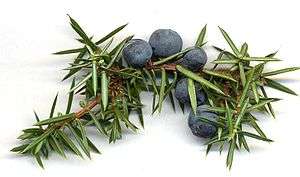
Junipers vary in size and shape from tall trees, 20–40 m (66–131 ft) tall, to columnar or low spreading shrubs with long trailing branches. They are evergreen with needle-like and/or scale-like leaves. They can be either monoecious or dioecious. The female seed cones are very distinctive, with fleshy, fruit-like coalescing scales which fuse together to form a "berry"-like structure, 4–27 mm (0.16–1.06 in) long, with 1–12 unwinged, hard-shelled seeds. In some species these "berries" are red-brown or orange but in most they are blue; they are often aromatic and can be used as a spice. The seed maturation time varies between species from 6–18 months after pollination. The male cones are similar to those of other Cupressaceae, with 6–20 scales.
In zones 7 through 10, junipers can bloom and release pollen several times each year. A few species of juniper bloom in autumn, while most species pollinate from early winter until late spring.[3]
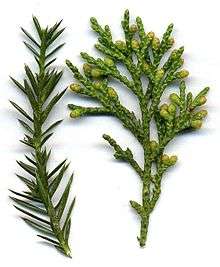
Many junipers (e.g. J. chinensis, J. virginiana) have two types of leaves: seedlings and some twigs of older trees have needle-like leaves 5–25 mm (0.20–0.98 in) long; and the leaves on mature plants are (mostly) tiny (2–4 mm (0.079–0.157 in)), overlapping and scale-like. When juvenile foliage occurs on mature plants, it is most often found on shaded shoots, with adult foliage in full sunlight. Leaves on fast-growing 'whip' shoots are often intermediate between juvenile and adult.
In some species (e. g. J. communis, J. squamata), all the foliage is of the juvenile needle-like type, with no scale leaves. In some of these (e.g. J. communis), the needles are jointed at the base, in others (e.g. J. squamata), the needles merge smoothly with the stem, not jointed.
The needle-leaves of junipers are hard and sharp, making the juvenile foliage very prickly to handle. This can be a valuable identification feature in seedlings, as the otherwise very similar juvenile foliage of cypresses (Cupressus, Chamaecyparis) and other related genera is soft and not prickly.
Juniper is the exclusive food plant of the larvae of some Lepidoptera species including Bucculatrix inusitata and juniper carpet, and is also eaten by the larvae of other Lepidoptera species such as Chionodes electella, Chionodes viduella, juniper pug and pine beauty; those of the tortrix moth C. duplicana feed on the bark around injuries or canker.
Junipers are gymnosperms, which means they have seeds, but no flowers or fruits. Depending on the species, the seeds they produce take 1–3 years to develop. The impermeable coat of the seed keeps water from getting in and protects the embryo when being dispersed. It can also result in a long dormancy that is usually broken by physically damaging the seed coat. Dispersal can occur from being swallowed whole by frugivores and mammals. The resistance of the seed coat allows it to be passed down through the digestive system and out without being destroyed along the way. These seeds last a long time, as they can be dispersed long distances over the course of a couple years.[4]
Classification
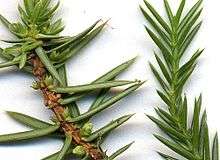
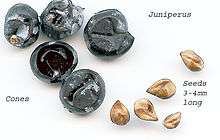
The number of juniper species is in dispute, with two recent studies giving very different totals, Farjon (2001) accepting 52 species, and Adams (2004) accepting 67 species. The junipers are divided into several sections, though (particularly among the scale-leaved species) which species belong to which sections is still far from clear, with research still on-going. The section Juniperus is an obvious monophyletic group though.
Juniperus sect. Juniperus: Needle-leaf junipers. The adult leaves are needle-like, in whorls of three, and jointed at the base (see below right).
- Juniperus sect. Juniperus subsect. Juniperus: Cones with 3 separate seeds; needles with one stomatal band.
- Juniperus communis – Common juniper
- Juniperus communis subsp. alpina – Alpine juniper
- Juniperus conferta – Shore juniper (syn. J. rigida var. conferta)
- Juniperus rigida – Temple juniper or needle juniper
- Juniperus communis – Common juniper
- Juniperus sect. Juniperus subsect. Oxycedrus: Cones with 3 separate seeds; needles with two stomatal bands.
- Juniperus brevifolia – Azores juniper
- Juniperus cedrus – Canary Islands juniper
- Juniperus deltoides – Eastern prickly juniper
- Juniperus formosana – Chinese prickly juniper
- Juniperus lutchuensis – Ryukyu juniper
- Juniperus navicularis – Portuguese prickly juniper
- Juniperus oxycedrus – Western prickly juniper or cade juniper
- Juniperus macrocarpa (J. oxycedrus subsp. macrocarpa) – Large-berry juniper
- Juniperus sect. Juniperus subsect. Caryocedrus: Cones with 3 seeds fused together; needles with two stomatal bands.
- Juniperus drupacea – Syrian juniper
Juniperus sect. Sabina: Scale-leaf junipers. The adult leaves are mostly scale-like, similar to those of Cupressus species, in opposite pairs or whorls of three, and the juvenile needle-like leaves are not jointed at the base (including in the few that have only needle-like leaves; see below right). Provisionally, all the other junipers are included here, though they form a paraphyletic group.
- Old World species
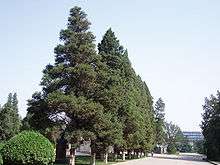
- Juniperus chinensis – Chinese juniper
- Juniperus convallium – Mekong juniper
- Juniperus excelsa – Greek juniper
- Juniperus excelsa polycarpos – Persian juniper
- Juniperus foetidissima – Stinking juniper
- Juniperus indica – Black juniper
- Juniperus komarovii – Komarov's juniper
- Juniperus phoenicea – Phoenicean juniper
- Juniperus pingii – Ping juniper
- Juniperus procera – East African juniper
- Juniperus procumbens – Ibuki juniper
- Juniperus pseudosabina – Xinjiang juniper
- Juniperus recurva – Himalayan juniper
- Juniperus sabina – Savin juniper
- Juniperus saltuaria – Sichuan juniper
- Juniperus semiglobosa – Russian juniper
- Juniperus squamata – Flaky juniper
- Juniperus thurifera – Spanish juniper
- Juniperus tibetica – Tibetan juniper
- Juniperus wallichiana – Himalayan black juniper
New World species
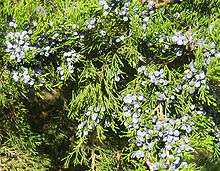
- Juniperus angosturana – Mexican one-seed juniper
- Juniperus ashei – Ashe juniper
- Juniperus arizonica – Synonym: Juniperus coahuilensis var. arizonica or Juniperus erythrocarpa var. coahuilensis. common names: Redberry juniper, roseberry juniper
- Juniperus barbadensis – West Indies juniper
- Juniperus bermudiana – Bermuda juniper
- Juniperus blancoi – Blanco's juniper
- Juniperus californica – California juniper
- Juniperus coahuilensis – Coahuila juniper
- Juniperus comitana – Comitán juniper
- Juniperus deppeana – Alligator juniper
- Juniperus durangensis – Durango juniper
- Juniperus flaccida – Mexican weeping juniper
- Juniperus gamboana – Gamboa juniper
- Juniperus horizontalis – Creeping juniper
- Juniperus jaliscana – Jalisco juniper
- Juniperus maritima – Seaside juniper
- Juniperus monosperma – One-seed juniper
- Juniperus monticola – Mountain juniper
- Juniperus occidentalis – Western juniper
- Juniperus occidentalis subsp. australis – Sierra juniper
- Juniperus osteosperma – Utah juniper
- Juniperus pinchotii – Pinchot juniper
- Juniperus saltillensis – Saltillo juniper
- Juniperus scopulorum – Rocky Mountain juniper
- Juniperus standleyi – Standley's juniper
- Juniperus virginiana – Eastern juniper (eastern redcedar)
- Juniperus virginiana subsp. silicicola – Southern juniper
- Juniperus zanonii (proposed)[5]
Ecology
Juniper plants thrive in a variety of environments. The junipers from Lahaul valley can be found in dry, rocky locations planted in stony soils. These plants are being rapidly used up by grazing animals and the villagers. There are several important features of the leaves and wood of this plant that cause villagers to cut down these trees and make use of them.[6] Additionally, the western juniper plants, a particular species in the juniper genus, are found in woodlands where there are large, open spaces. Junipers are known to encompass open areas so that they have more exposure to rainfall.[4] Decreases in fires and a lack of livestock grazing are the two major causes of western juniper takeover. This invasion of junipers is driving changes in the environment. For instance, the ecosystem for other species previously living in the environment and farm animals has been compromised.[7] When junipers increase in population, there is a noticeable decrease in woody species like mountain big sagebrush and aspen. Among the juniper trees themselves, there is a lot of competition. The cost of this is a decrease in berry production.[8] The herbaceous cover has decreased and oftentimes junipers are mistaken to be weeds. As a result, several farmers have thinned the juniper trees or removed them completely. However, this reduction did not result in any significant difference on wildlife survival. Some small mammals found it advantageous to have thinner juniper trees, while cutting down the entire tree was not favorable.[9][10]
Cultivation and uses
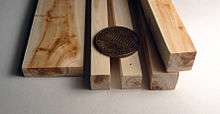

Some junipers are susceptible to Gymnosporangium rust disease, and can be a serious problem for those people growing apple trees, the alternate host of the disease.
Timber
Some junipers are given the common name "cedar," including Juniperus virginiana, the "red cedar" that is used widely in cedar drawers. "Eastern redcedar" is the correct name for J. virginiana. The lack of space between the words "red" and "cedar" indicates that this species is not a true cedar, Cedrus.
Juniper in weave is a traditional cladding technique used in Northern Europe, e.g. at Havrå, Norway.[11]
Culinary use
Juniper berries are a spice used in a wide variety of culinary dishes and best known for the primary flavoring in gin (and responsible for gin's name, which is a shortening of the Dutch word for juniper, jenever). A juniper based spirit is made by fermenting juniper berries and water to create a "wine" that is then distilled. This is often sold as a juniper brandy in eastern Europe. Juniper berries are also used as the primary flavor in the liquor Jenever and sahti-style of beers. Juniper berry sauce is often a popular flavoring choice for quail, pheasant, veal, rabbit, venison and other game dishes.
Essential oil

Juniper berries are steam distilled to produce an essential oil that may vary from colorless to yellow or pale green. Some of its chemical components are alpha pinene, cadinene, camphene and terpineol. Leaves and twigs of Juniperus virginiana are steam distilled to produce oil of juniper. Middle Tennessee and adjacent northern Alabama and southern Kentucky are the centers for this activity. The U.S. Forest Service has provided plans for the apparatus required. This work is typically done during periods of cold weather to reduce the loss of essential oil to evaporation, which is greater in warmer weather, and to take advantage of a time of year when labor might be more readily available.
Ethnic and herbal use
Many of the earliest prehistoric people lived in or near juniper forests which furnished them food, fuel, and wood for shelter or utensils. In Morocco, the tar (gitran) of the arar tree (Juniperus phoenicea) is applied in dotted patterns on bisque drinking cups. Gitran makes the water more fragrant and is said to be good for the teeth.
Some Indigenous peoples, such as the Dineh, have traditionally used juniper for diabetes.[12] Native Americans have also used juniper berries as a female contraceptive.[13] The 17th Century herbalist physician Nicholas Culpeper recommended the ripened berries for conditions such as asthma and sciatica, as well as to speed childbirth.[14] The plant was long used as an arbortifacient [15] and was known as 'bastard killer' in the UK.[16]
Juniper is one of the plants used in Scottish and Gaelic Polytheist saining rites, such as those performed at Hogmanay (New Year), where the smoke of burning juniper is used to cleanse, bless, and protect the household and its inhabitants.[17][18][19]
Juniper ash is considered to be one of the main sources of calcium for the Navajo people. It is usually an ingredient in blue corn meals. They incorporate the juniper ash because of the flavor it provides. Therefore, it can be found in different kinds of corn-based foods such as pancakes or dumplings. The use of juniper ash is important because many Navajo people don't drink animal milk, which is a major source of calcium in some diets. One teaspoon of juniper ash can contribute the same amount of calcium in one cup of milk. The majority of the calcium was derived from woody branches of juniper plants.[20][21]
Antioxidants
Juniper berries can be useful because of their antioxidant properties. In folk medicine, it is believed to be helpful with diseases such as bronchitis and arthritis. Similarly, the juniper berry oil has antimicrobial properties; specifically, it works well against fungi. Common features useful in medicine are diuretic properties, gastrointestinal irritant properties, and antiseptic properties.[22][23]
Wood and leaves
Local people in Lahaul Valley present juniper leaves to their deities as a folk tradition. It is also useful as a folk remedy for pains and aches as well as epilepsy and asthma. They are reported to collect large amounts of juniper leaves and wood for building and religious purposes.[6]
Ornamental use

Junipers are among the most popular conifers to be cultivated as ornamental subjects for parks and gardens. They have been bred over many years to produce a wide range of forms, in terms of colour, shape and size. They include some of the dwarfest (miniature) cultivars. They are also used for bonsai. Species found in cultivation include:-
- J. chinensis
- J. communis
- J. horizontalis
- J. × pfitzeriana
- J. procumbens
- J. rigida
- J. scapulorum
- J. squamata
Allergenic potential
In drier areas, juniper pollen easily becomes airborne and can be inhaled into the lungs. This pollen can also irritate the skin and cause contact dermatitis. Cross-allergenic reactions are common between juniper pollen and the pollen of all species of cypress.[3]
Monoecious juniper plants are highly allergenic, with an OPALS allergy scale rating of 9 out of 10. Completely male juniper plants have an OPALS rating of 10, and release abundant amounts of pollen. Conversely, all-female juniper plants have an OPALS rating of 1, and are considered "allergy-fighting".[3]
References
- ↑ Sunset Western Garden Book, 1995:606–607
- ↑ Hampe, Hampe; Petit, Re´my J. (2010). "Cryptic forest refugia on the 'Roof of the World'". New Phytologist. 185 (1): 5–7. doi:10.1111/j.1469-8137.2009.03108.x. PMID 20088971. Retrieved 2 September 2015.
- 1 2 3 Ogren, Thomas (2015). The Allergy-Fighting Garden. Berkeley, CA: Ten Speed Press. pp. 131–133. ISBN 978-1-60774-491-7.
- 1 2 Chamber, J.C., S.B. Vander Wall., and E.W. Schupp. 1999. Seed and seedling ecology of pinon and juniper species in the pygmy woodlands of western North America. The Botanical Review 65(1):1–38.
- ↑ Adams, Robert. "Phytologia (April 2010) 92(1)" (PDF). Archived from the original (PDF) on 2011-07-21.
- 1 2 Rawat, Yashwant S.; Everson, Colin S. (2012-10-01). "Ecological status and uses of juniper species in the cold desert environment of the Lahaul valley, North-western Himalaya, India". Journal of Mountain Science. 9 (5): 676–686. doi:10.1007/s11629-012-2274-0. ISSN 1672-6316.
- ↑ Belsky, A. Joy (1996). "Viewpoint: Western Juniper Expansion: Is It a Threat to Arid Northwestern Ecosystems?". Journal of Range Management. 49 (1): 53–59. doi:10.2307/4002725. JSTOR 4002725.
- ↑ Miller, Richard F.; Svejcar, Tony J.; Rose, Jeffrey A. (2000). "Impacts of Western Juniper on Plant Community Composition and Structure". Journal of Range Management. 53 (6): 574–585. doi:10.2307/4003150. JSTOR 4003150.
- ↑ Bombaci, Sara; Pejchar, Liba (2016). "Consequences of pinyon and juniper woodland reduction for wildlife in North America". Forest Ecology and Management. 365: 34–50. doi:10.1016/j.foreco.2016.01.018.
- ↑ Gallo, Travis; Stinson, Lani T.; Pejchar, Liba (2016). "Pinyon-juniper removal has long-term effects on mammals". Forest Ecology and Management. 377: 93–100. doi:10.1016/j.foreco.2016.06.029.
- ↑ Berge, Bjørn (2009). The Ecology of Building Materials (2nd ed.). Taylor & Francis. ISBN 978-1-85617-537-1.
- ↑ McCabe, Melvina; Gohdes, Dorothy; Morgan, Frank; Eakin, Joanne; Sanders, Margaret; Schmitt, Cheryl (2005). "Herbal Therapies and Diabetes Among Navajo Indians". Diabetes Care. 28 (6): 1534–1535. doi:10.2337/diacare.28.6.1534-a.
- ↑ Tilford, Gregory L. (1997). Edible and Medicinal Plants of the West. Mountain Press Publishing Company. ISBN 0-87842-359-1.
- ↑ Culpeper, Nicholas (1985). Culpeper's Complete Herbal. Godfrey Cave Associates. ISBN 1-85007-026-1.
- ↑ "Saffron - savin - juniper". Plant Lore.
- ↑ G. Grigson, The Englishman’s Flora, 1987: 24
- ↑ McNeill, F. Marian (1961). "X Hogmany Rites and Superstitions". The Silver Bough, Vol.3: A Calendar of Scottish National Festivals, Halloween to Yule. Glasgow: William MacLellan. p. 113. ISBN 0-948474-04-1.
- ↑ Loughlin, Annie "Saining" at Tairis UK. Accessed 8-6-14
- ↑ Loughlin, Annie "Saining Ritual" at Tairis UK. Accessed 8-6-14
- ↑ Christensen, Nedra K; Sorenson, ANN W; Hendricks, Deloy G; Munger, Ronald (1998). "Juniper Ash as a Source of Calcium in the Navajo Diet". Journal of the American Dietetic Association. 98 (3): 333. doi:10.1016/s0002-8223(98)00077-7. PMID 9508018.
- ↑ Ballew, Carol; White, Linda L.; Strauss, Karen F.; Benson, Lois J.; Mendlein, James M.; Mokdad, Ali H. (1997-10-01). "Intake of Nutrients and Food Sources of Nutrients among the Navajo: Findings from the Navajo Health and Nutrition Survey". The Journal of Nutrition. 127 (10): 2085S–2093S. doi:10.1093/jn/127.10.2085s. ISSN 0022-3166.
- ↑ El-Ghorab, Ahmed; Shaaban, Hamdy A.; El-Massry, Khaled F.; Shibamoto, Takayuki (2008-07-01). "Chemical Composition of Volatile Extract and Biological Activities of Volatile and Less-Volatile Extracts of Juniper Berry (Juniperus drupacea L.) Fruit". Journal of Agricultural and Food Chemistry. 56 (13): 5021–5025. doi:10.1021/jf8001747. ISSN 0021-8561.
- ↑ Pepeljnjak, S., I. Kosalec, Z. Kalodera, and N. Blazevic. 2005. Antimicrobial activity of juniper berry essential oil (Juniperus communis L., Cupressaceae). Acta Pharm. 55:417-422.
- Adams, R. P. (2004). Junipers of the World: The genus Juniperus. Victoria: Trafford. ISBN 1-4120-4250-X
- Farjon, A. (2001). World Checklist and Bibliography of Conifers. Kew. ISBN 1-84246-025-0
- Farjon, A. (2005). Monograph of Cupressaceae and Sciadopitys. Royal Botanic Gardens, Kew. ISBN 1-84246-068-4
- Mao, K.; Hao, G.; Liu, J.; Adams, R. P.; Milne (2010). "Diversification and biogeography of Juniperus (Cupressaceae): variable diversification rates and multiple intercontinental dispersals". New Phytologist. 188 (1): 254–272. doi:10.1111/j.1469-8137.2010.03351.x. PMID 20561210.
External links
| Wikimedia Commons has media related to Juniperus. |
- Junipers of the world
- Gymnosperm Database - Juniperus
- "Juniperus". The Plant List. Missouri Botanical Garden. Royal Botanic Gardens, Kew.
- Arboretum de Villardebelle Photos of cones and foliage of selected species

